2013 Polaris 600 Switchback Review – Video

Polaris' 600 Switchback is quite a "basic" bargain
Things that we like about the Polaris Switchback? Pretty much everything. Sure, given a choice between a dressed version with Walker Evans shocks and a top of the line 800cc engine or the basic 600 Switchback model, we’d go with the top of the line every time. That said, we’ll readily admit that we could live quite happily with the base 600 Switchback.
Engine Type:Horizontal In-line
Cylinders:2
Engine Stroke:2-Stroke
Valve Configuration:Reed Valve
Displacement:599 / 36.6
Starter:Pull
Turbocharged:No
View Full SpecA base Switchback can sate our palate for trail adventures. Look at these facts. The basic model and the top line models share the same fundamental design in front suspension, rear suspension, platform design, seating ergonomics and the like. The key differential lies in the finishing pieces.
Get the Flash Player to see this player. |
The basics get enhanced for model year 2013 with a much more precise steering system, with major credit going to the new Pro Steer ski. Added to the racing-inspired double A-arm front suspension, this new ski has a revised keel design that addresses the trail more positively and allows the use of a shorter runner. The result is much improved bite, greater directional control while actually reducing effort through the handlebar. In chatting with Polaris engineers we learned that this new ski serves as a major point of pride as you’ll note with a careful review of its construction. While many of us tend to see the ski at the front of the sled, we rarely see it in the detail that the Polaris engineering staff does. For example, the ski top features redesigned ribbing that gives the Pro Steer ski a unique style, but more importantly an increase in torsional rigidity that will maintain ski-to-snow contact for improved steering control. You’ll also note how the ski flares to minimize kicked up snow dust when cornering and how the ski ribbing gains a raised area that gives you added traction if you need to step out on the ski when off-trailing in deep snow.
Yes, the top line Switchback gets the fun to play with Walker Evans multi-adjustability, but the standard Pro-Ride front suspension comes with premium grade high pressure Fox gas shocks. If you like to ride and keep trailside tinkering to a minimum, this is the front end for you. In recent years we have found that Polaris engineering manages to fine tune the base suspension packages extremely well, giving owners a very nice blend between cush and crash. As a trail rider you will enjoy a controlled ride that will provide excellent qualities for all day cruising. But if you have a need to crash and charge through the unbroken snows of unplowed fire roads or off-trail excursions, the base setup works very well, too.
Polaris designers worked hard to blend in a racer-type front end that is balanced for easy steering and virtually eliminates the variables of bump steer. The 600 Switchback we tested in West Yellowstone this past winter offered positive but light steering feedback with improvements in flat cornering. Polaris claims a 20 percent reduction in steering effort. We can’t provide a definitive number to this, but we did feel a noticeably lighter effort – some of which directly relates to the new ski.
You’ll also enjoy the under seat ride that comes on the Switchback’s Pro-Ride chassis and 136-inch parallel rail rear suspension. We tend to think of the Switchback as the stretched out Rush as it expands on the principles Polaris brought out with that uniquely suspended short track model. The strengths of the chassis and suspension seem to work wonderfully well in the Switchback. We feel that the elongation relaxes the suspension’s hyper activity from the Rush, leading to a much more pleasant ride and better overall control of the sled both on trail and off. Even though the chassis is longer, we thought the sled turned into corners more efficiently with a neutral balance in steering that brought the rear around in a positive fashion. Where the Rush leaves us with the impression of too much push, the Switchback, which we assumed would be a push monster, corners very easily. This makes it very good for powering around and through off-trail snows.
As the base model, the 2013 Polaris 600 Switchback ($10,399) features the smaller of the company’s two Cleanfire semi-direct injected two-stroke twins. The 800cc is more potent, but in the flatlands of Minnesota or Ontario, the base 600cc twin works extremely well. Thank Polaris for going with the same 600 twin that the company uses in the 600 RMK. This version features improvements in the injection system that give you nearly instant-on response. Quick, crisp and positive. That’s the throttle response you need for off-trail riding and it’s what you get. If you prefer spending most of your time on groomed trails, you’ll approve of this upgrade as it allows you to corner on the throttle. The engine and Polaris clutching components work great together, giving you a good blend of free-wheeling and engine backing to make hot rodding on twisty trails a heck of a lot of fun.
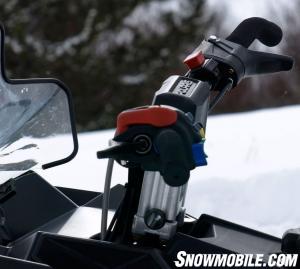 The new handlebar design is fitted to most new for 2013 Polaris models.
The new handlebar design is fitted to most new for 2013 Polaris models.
For 2013 Polaris gives us an upgraded handlebar that is now one piece with a natural curvature for vastly improved comfort and positive cornering capability. Taking a page from the Yamaha book of handgrip heating, the new Polaris bar features a heater element that extends to the bar ends. The new bar gets a very positive review from us – finally and “Thank you!”
Going along with the new bar is a redesigned throttle block that separates the kill switch so you can independently adjust these controls. Not a big deal, but more of a redesign that was necessitated by going with the new curved one-piece handlebar.
These changes in ergonomics bolster an already ergonomically superior snowmobile. Ah, heck, we’ve always felt that the Rush and Switchback closely follow the Ski-Doo REV designs when you sit back and look out over the windshield. We get a similar feel when seated aboard one to the other. You sit upright. The feel is of a narrow, responsive sled. Credit cowl styling to give you that feeling as the design seems to narrow from the side up to the windshield. But we have noticed that Polaris makes an effort to reduce flying snow and cold from slamming into your legs and torso as much as before. There are surfaces designed to break up air and snow flow when you’re underway.
As a base sled, the 600 Switchback scores high with us. The ride is a great blend for on and off trail, although this Switchback will better suit riders who stay on trail more than off. If you want more off-trail performance, there is the Assault and the 600 RMK, both better choices than this version.
What we like is the solid flat land performance of the proven Cleanfire 600 twin, the extra length of this Rush-based sled, the ergonomic handlebar upgrade, the new steering and cornering agility from the revised ski and updated front end. As a base model, the 2013 Polaris 600 Switchback is a pure bargain for serious but penurious snowmobilers.
| 2013 Polaris 600 Switchback Specs | |
| Engine | Polaris Liberty Cleanfire 599cc twin cylinder 2-stroke; liquid-cooled; Cleanfire fuel injection |
| Horsepower | 120-plus |
| Drive | Polaris P-85 drive, P2 driven |
| Front Suspension | Polaris Pro-Ride; 9-in maximum travel; Fox gas shocks with internal floating piston |
| Rear Suspension | Polaris Pro-Ride slide rail 136-in; Fox gas with internal floating piston shocks; 14-inch maximum travel |
| Length | 115.0 in |
| Width | 48.0 in |
| Height | 50.0 in |
| Ski Stance | 42.5 in |
| Track | 15 x 136 x 1.25 Rip Saw |
| Weight | 520 (claimed) |
| Brake | Polaris Phantom hydraulic |
| Fuel Capacity | 11.0 US Gal |
| Features | Standard: new curvature handlebar with 4.5-in riser; Multi-function gauge; Electronic reverse (PERC); Available: electrical outlets; security system; electric start |
| MSRP | US$10,399 |
Related Reading
2013 Polaris 600 Indy SP Review – Video
2012 Polaris 600 Switchback Review
2012 Polaris 600 Rush Review



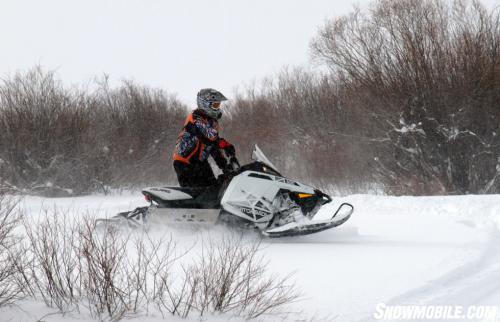
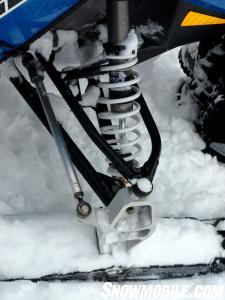
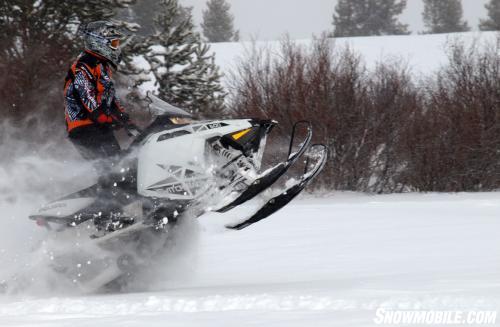
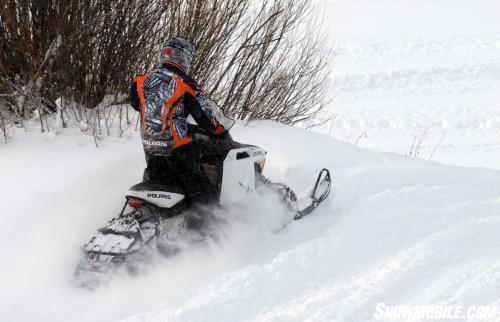
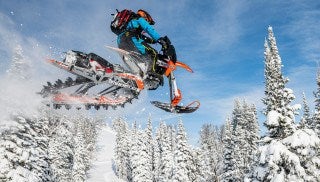




 Your Privacy Choices
Your Privacy Choices